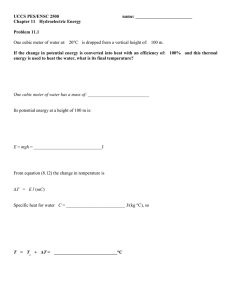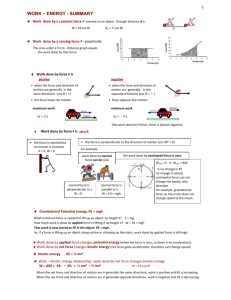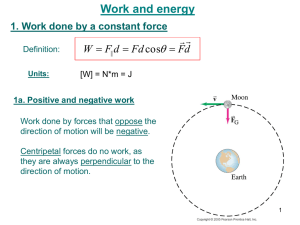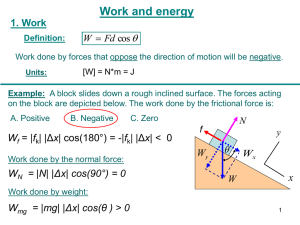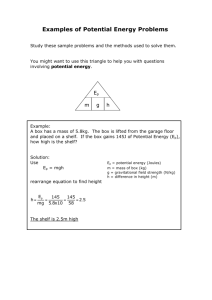W U
advertisement
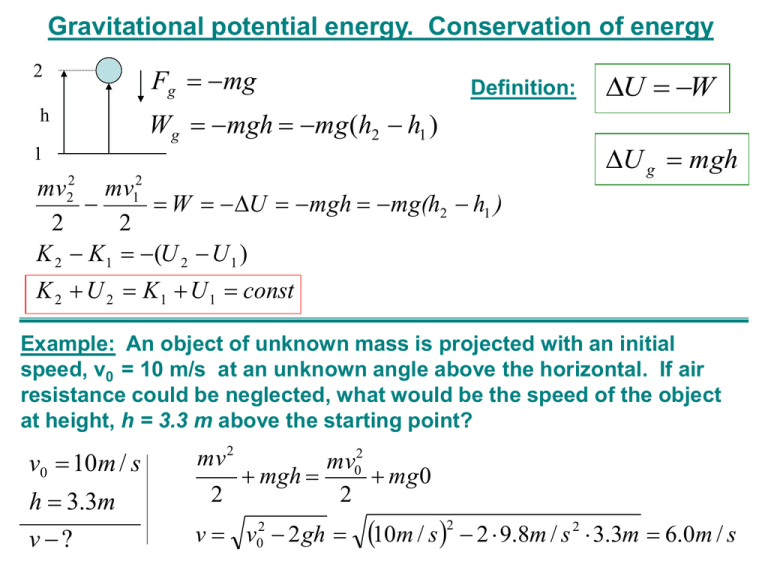
Gravitational potential energy. Conservation of energy 2 h Fg mg Definition: Wg mgh mg (h2 h1 ) 1 mv22 mv12 W U mgh mg(h2 h1 ) 2 2 K 2 K 1 (U 2 U 1 ) U W U g mgh K 2 U 2 K 1 U 1 const Example: An object of unknown mass is projected with an initial speed, v0 = 10 m/s at an unknown angle above the horizontal. If air resistance could be neglected, what would be the speed of the object at height, h = 3.3 m above the starting point? v0 10m / s mv 2 h 3.3m v ? v v02 2 gh mv02 mgh mg 0 2 2 10m / s 2 2 9.8m / s 2 3.3m 6.0m / s Example: A box of unknown mass and initial speed v0 = 10 m/s moves up a frictionless incline angled 30°. How high does the box go before it begins sliding down? A. 2 m B. 5 m C. 10 m m 30° Only gravity does work (the normal is perpendicular to the motion), so mechanical energy is conserved. E K U 1 E A mv 02 0 2 EB 0 mgh 1 EA EB mv 02 mgh 2 v 02 (10 m/s)2 h 5 m 2 2 g 2(10 m/s ) The really nice thing is, we can apply the same thing to any “incline” The really nice thing is, we can apply the same thing to any “incline”: Turnaround point: where K=0 E K v=0 U E K U h E K U Example: Roller Coaster A roller coaster starts out at the top of a hill of height h. How fast is it going when it reaches the bottom? h Energyinitial Energy final U initial mgh K final mv 2 2 mv2 mgh 2 v 2 gh Example: Paul and Kathleen start from rest at the same time on frictionless water slides with different shapes. a) At the bottom, whose velocity is greater? The only force doing work is gravity mechanical energy is conserved: Ei = mgh = Ef = 1/2 mv2 gh = 1/2 v2 Since they both start from the same height, they have the same velocity at the bottom. 1) Paul 2) Kathleen 3) both the same b) Who makes it to the bottom first? Even though they both have the same final velocity, Kathleen is at a lower height than Paul for most of her ride. Thus she always has a larger velocity during her ride and therefore arrives earlier! Example: A cart is released from height h in a roller coaster with a loop of radius R. What is the minimum h to keep the cart on the track? E A EB vB2 mg N m R 1 mgh 0 mg 2R mvB2 2 The minimum velocity is fixed by N = 0: mg m A 2 vB,min R vB,min The minimum height is given by: gR h vB 2 g (h 2R ) R 2hmin 4R hmin 5 R 2 2 g (hmin 2R ) B mg+N R gR Example: A pebble of mass m sits on top of the perfectly spherical head of a snow man. When given a very slight push, it starts sliding down. Where does it leave the snow man’s head? v2 mg cos N m R N θ As v increases, N decreases. When N = 0, the pebble flies off. R mg cos max m mg Conservation of energy: 2 mgR 12 mvmax v 2 max R mgR cos max 2 equations for vMAX and θMAX 2 gR (1 cosMAX ) Rg cosMAX cosMAX 2 3 (MAX 48.2 ) Example: Pendulum (Conservation of energy) Only weight of the pendulum is doing work; weight is a conservative force, so mechanical energy is conserved: K U const L m K 0 U max θ0 θ0 U mgh mv 2 K 2 K max U min K 0 U max The angle on the other side is also θ0. Example: Pendulum (Conservation of energy) The pendulum with a mass of 300 g is deviated from the equilibrium position B to the position A as shown below. Find the speed of the pendulum at the point B after the pendulum is released. A. Energy of the pendulum at the point A: U A mgh (0.3kg)(9.8 A m )(0.2m) 0.58 J 2 s KA 0 B h 20cm v B. Energy of the pendulum at the point B: mv 2 KB 2 UB 0 C. Conservation of energy: K U const mv 2 0 mgh 0 2 v 2K B m 2(0.58 J ) 1.97 m / s 0.3kg v 2 gh 2 9.8m / s 2 0.2m 1.97m / s Example: A 5.00 g block is pushed against a spring with k = 8.00 N/m. The spring is initially compressed 5.00 cm and then released. The coefficient of kinetic friction between the block and the table is 0.600. What is the speed of the block at x = 0? x = 0, equilibrium x k m Einitial 1 2 0 kx 2 v? μk E final 1 mv 2 0 2 1 1 2 2 mv kx k mgx 2 2 v Wfriction k mgx kx 2 v 2k gx m (8.00 N/m)(0.05 m)2 2(0.600)(9.81 m/s2 )(0.05 m) 1.85 m/s 0.005 kg Example: A box sliding on a horizontal frictionless surface runs into a fixed spring and compresses it to a maximum distance x1 before bouncing back. If the initial speed of box is doubled and its mass if halved, how far (x2) would the spring be compressed? x1 A. x2 = x1 Ef =Ei B. x2 =2 x1 1 2 kx 12 mv 2 C. x2 = 2x1 2 m x v k x2 m2 v22 x1 m1v12 Example: Spring 1 is stiffer then spring 2; that is k1 > k2. The spring force F of which spring does more work if the springs compressed by the same applied force? A. W1 <W2 B. W1 >W2 C. W1 =W2 F=-kx x=-F/k W=½Fx=½F(-F/k)=-½F2/k Example: A ball is shot by a vertical spring compressed over a distance x1 as shown below. It reaches a height h1 above the initial position. If the spring is compressed over a distance x2 = 2x1, the maximum height h2 is: 1 Before the shot: E kx12 2 (vinitial 0) After the shot: E mgh1 (v top 0) 1 kx12 mgh1 2 x2 = 2x1 k h1 x12 2mg h2 =4h1 h x Energy Conservation 1. Mechanical energy conservation E K U 0 E K U For closed isolated system 2. Open system K U Eint Wext U Wcons Eint Wnoncons 3. Conservative and nonconservative forces •Forces such as gravity or the elastic force, for which the work dose not depend on the path taken but only on the initial and final position, are called conservative forces •For conservative forces the work done on a closed path (a lop) is equal to zero •Friction is a nonconservative force Example: A hammer slides along 10 m down a 30 inclined roof and off into the yard, which is 7 m below the roof edge. Right before it hits the ground, its speed is 14.5 m/s. What is the coefficient of kinetic friction between the hammer and the roof? Δx = 10 m h’ 30 This can be solved using Newton’s laws and kinematics, but it’s looooooooooooooooooooooooong. h=7m v = 14.5 m/s 1 mv 2 mg x sin k mg cos x mgh 2 k 2 g h x sin v 2 2 g x cos 2(9.8) 7 10 sin30 14.52 1.5 2(9.8)10cos30

